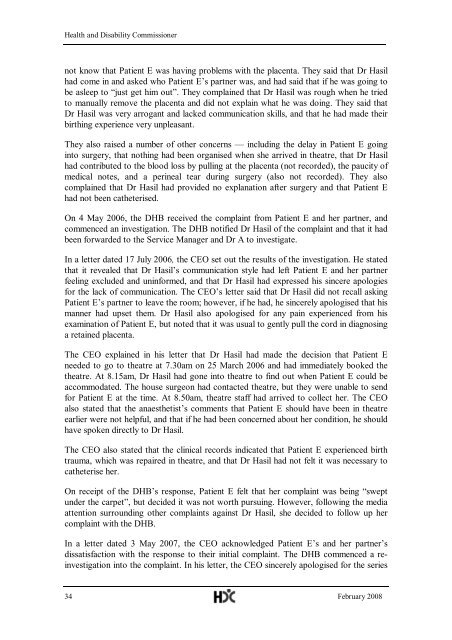Roman Hasil and the Whanganui DHB - Health and Disability ...
Roman Hasil and the Whanganui DHB - Health and Disability ...
Roman Hasil and the Whanganui DHB - Health and Disability ...
You also want an ePaper? Increase the reach of your titles
YUMPU automatically turns print PDFs into web optimized ePapers that Google loves.
<strong>Health</strong> <strong>and</strong> <strong>Disability</strong> Commissioner<br />
not know that Patient E was having problems with <strong>the</strong> placenta. They said that Dr <strong>Hasil</strong><br />
had come in <strong>and</strong> asked who Patient E’s partner was, <strong>and</strong> had said that if he was going to<br />
be asleep to “just get him out”. They complained that Dr <strong>Hasil</strong> was rough when he tried<br />
to manually remove <strong>the</strong> placenta <strong>and</strong> did not explain what he was doing. They said that<br />
Dr <strong>Hasil</strong> was very arrogant <strong>and</strong> lacked communication skills, <strong>and</strong> that he had made <strong>the</strong>ir<br />
birthing experience very unpleasant.<br />
They also raised a number of o<strong>the</strong>r concerns — including <strong>the</strong> delay in Patient E going<br />
into surgery, that nothing had been organised when she arrived in <strong>the</strong>atre, that Dr <strong>Hasil</strong><br />
had contributed to <strong>the</strong> blood loss by pulling at <strong>the</strong> placenta (not recorded), <strong>the</strong> paucity of<br />
medical notes, <strong>and</strong> a perineal tear during surgery (also not recorded). They also<br />
complained that Dr <strong>Hasil</strong> had provided no explanation after surgery <strong>and</strong> that Patient E<br />
had not been ca<strong>the</strong>terised.<br />
On 4 May 2006, <strong>the</strong> <strong>DHB</strong> received <strong>the</strong> complaint from Patient E <strong>and</strong> her partner, <strong>and</strong><br />
commenced an investigation. The <strong>DHB</strong> notified Dr <strong>Hasil</strong> of <strong>the</strong> complaint <strong>and</strong> that it had<br />
been forwarded to <strong>the</strong> Service Manager <strong>and</strong> Dr A to investigate.<br />
In a letter dated 17 July 2006, <strong>the</strong> CEO set out <strong>the</strong> results of <strong>the</strong> investigation. He stated<br />
that it revealed that Dr <strong>Hasil</strong>’s communication style had left Patient E <strong>and</strong> her partner<br />
feeling excluded <strong>and</strong> uninformed, <strong>and</strong> that Dr <strong>Hasil</strong> had expressed his sincere apologies<br />
for <strong>the</strong> lack of communication. The CEO’s letter said that Dr <strong>Hasil</strong> did not recall asking<br />
Patient E’s partner to leave <strong>the</strong> room; however, if he had, he sincerely apologised that his<br />
manner had upset <strong>the</strong>m. Dr <strong>Hasil</strong> also apologised for any pain experienced from his<br />
examination of Patient E, but noted that it was usual to gently pull <strong>the</strong> cord in diagnosing<br />
a retained placenta.<br />
The CEO explained in his letter that Dr <strong>Hasil</strong> had made <strong>the</strong> decision that Patient E<br />
needed to go to <strong>the</strong>atre at 7.30am on 25 March 2006 <strong>and</strong> had immediately booked <strong>the</strong><br />
<strong>the</strong>atre. At 8.15am, Dr <strong>Hasil</strong> had gone into <strong>the</strong>atre to find out when Patient E could be<br />
accommodated. The house surgeon had contacted <strong>the</strong>atre, but <strong>the</strong>y were unable to send<br />
for Patient E at <strong>the</strong> time. At 8.50am, <strong>the</strong>atre staff had arrived to collect her. The CEO<br />
also stated that <strong>the</strong> anaes<strong>the</strong>tist’s comments that Patient E should have been in <strong>the</strong>atre<br />
earlier were not helpful, <strong>and</strong> that if he had been concerned about her condition, he should<br />
have spoken directly to Dr <strong>Hasil</strong>.<br />
The CEO also stated that <strong>the</strong> clinical records indicated that Patient E experienced birth<br />
trauma, which was repaired in <strong>the</strong>atre, <strong>and</strong> that Dr <strong>Hasil</strong> had not felt it was necessary to<br />
ca<strong>the</strong>terise her.<br />
On receipt of <strong>the</strong> <strong>DHB</strong>’s response, Patient E felt that her complaint was being “swept<br />
under <strong>the</strong> carpet”, but decided it was not worth pursuing. However, following <strong>the</strong> media<br />
attention surrounding o<strong>the</strong>r complaints against Dr <strong>Hasil</strong>, she decided to follow up her<br />
complaint with <strong>the</strong> <strong>DHB</strong>.<br />
In a letter dated 3 May 2007, <strong>the</strong> CEO acknowledged Patient E’s <strong>and</strong> her partner’s<br />
dissatisfaction with <strong>the</strong> response to <strong>the</strong>ir initial complaint. The <strong>DHB</strong> commenced a reinvestigation<br />
into <strong>the</strong> complaint. In his letter, <strong>the</strong> CEO sincerely apologised for <strong>the</strong> series<br />
34 February 2008

















